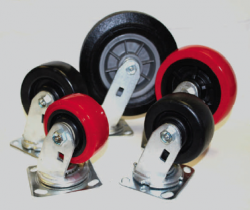 The most important considerations in proper caster selection is load weight, followed by rolling surface, rollability, the working environment and for the budget-conscious, cost. Sometimes when there is overlapping considerations such as capacity versus rolling surface or floor protection, a compromise may be necessary. It’s important to understand basic construction of a caster. The caster is compromised of the wheel, the steel fork or rig and the axle. Changing any or all of these components can change the capacity, rollability or the comparability with the rolling surface. Use this caster selection guide to aid in determining your casters.
The most important considerations in proper caster selection is load weight, followed by rolling surface, rollability, the working environment and for the budget-conscious, cost. Sometimes when there is overlapping considerations such as capacity versus rolling surface or floor protection, a compromise may be necessary. It’s important to understand basic construction of a caster. The caster is compromised of the wheel, the steel fork or rig and the axle. Changing any or all of these components can change the capacity, rollability or the comparability with the rolling surface. Use this caster selection guide to aid in determining your casters.
LOAD CAPACITY is easy to determine. Take the tare weight of the cart and add the estimated weight of the load and divide by four (4). We cut that by half as a safety consideration on all of our carts. You can increase the load capacity of a cart by increasing the wheel diameter, wheel width, wheel composition, the type of axle bearing used or the number of casters. As an example if you upgrade from a 3″ hard rubber caster to a 5″ hard rubber caster you will increase the capacity by 400 pounds. If you change the composition of the wheel to a HD Polyolefin, you will increase the total cart capacity by 600 pounds.
ROLLING SURFACE can be a fairly complex subject. The four most important considerations are protecting the caster, protecting the floor, ease of roll and noise. As a general rule, harder, larger diameter and larger width wheels will carry more weight but are noisier and will damage soft floors, such as wood. Softer composition wheels will carry less weight, be less noisy, provide better floor protection and pass over floor obstructions more easily, but will pick up debris that will wear the casters prematurely. There are wheels that will accomplish most of your objectives. Remember it is less costly to maintain your casters than your floor.
ROLLABILITY or the ease with which a cart will move is determined by the rolling surface as it relates to the diameter and tread width of the wheel, tread composition and the bearings used.
UNUSUAL CONDITIONS, especially unusual environmental conditions such as exposure to chemicals, oils, solvents or grease, extreme heat or cold and excessive moisture all need to be examined when selecting the wheel composition, rig and bearings.
